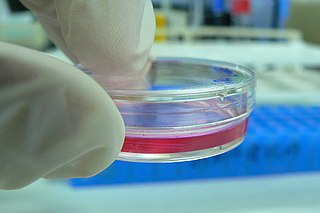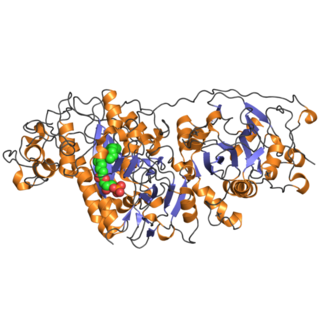
The immune system is a host defense system comprising many biological structures and processes within an organism that protects against disease. To function properly, an immune system must detect a wide variety of agents, known as pathogens, from viruses to parasitic worms, and distinguish them from the organism's own healthy tissue. In many species, there are two major subsystems of the immune system: the innate immune system and the adaptive immune system. Both subsystems use humoral immunity and cell-mediated immunity to perform their functions. In humans, the blood–brain barrier, blood–cerebrospinal fluid barrier, and similar fluid–brain barriers separate the peripheral immune system from the neuroimmune system, which protects the brain.
Morphogenesis is the biological process that causes an organism to develop its shape. It is one of three fundamental aspects of developmental biology along with the control of cell growth and cellular differentiation, unified in evolutionary developmental biology (evo-devo).

Psoriasis is a long-lasting autoimmune disease characterized by raised areas of abnormal skin. These areas are typically red, or purple on some people with darker skin, dry, itchy, and scaly. Psoriasis varies in severity from small, localized patches to complete body coverage. Injury to the skin can trigger psoriatic skin changes at that spot, which is known as the Koebner phenomenon.

HeLa is an immortal cell line used in scientific research. It is the oldest and most commonly used human cell line. The line was derived from cervical cancer cells taken on February 8, 1951 from Henrietta Lacks, a 31-year-old African-American mother of 5, who died of cancer on October 4, 1951. The cell line was found to be remarkably durable and prolific, which causes it to be used extensively in scientific study.

Nanobacterium is the unit or member name of a former proposed class of living organisms, specifically cell-walled microorganisms, now discredited, with a size much smaller than the generally accepted lower limit for life. Originally based on observed nano-scale structures in geological formations, the status of nanobacteria was controversial, with some researchers suggesting they are a new class of living organism capable of incorporating radiolabeled uridine, and others attributing to them a simpler, abiotic nature. One skeptic dubbed them "the cold fusion of microbiology", in reference to a notorious episode of supposed erroneous science. The term "calcifying nanoparticles" (CNPs) has also been used as a conservative name regarding their possible status as a life form.

The Philadelphia chromosome or Philadelphia translocation (Ph) is a specific genetic abnormality in chromosome 22 of leukemia cancer cells. This chromosome is defective and unusually short because of reciprocal translocation, t(9;22)(q34;q11), of genetic material between chromosome 9 and chromosome 22, and contains a fusion gene called BCR-ABL1. This gene is the ABL1 gene of chromosome 9 juxtaposed onto the breakpoint cluster region BCR gene of chromosome 22, coding for a hybrid protein: a tyrosine kinase signalling protein that is "always on", causing the cell to divide uncontrollably by interrupting the stability of the genome and impairing various signaling pathways governing the cell cycle.
Interleukins (ILs) are a group of cytokines that were first seen to be expressed by white blood cells (leukocytes). ILs can be divided into four major groups based on distinguishing structural features. However, their amino acid sequence similarity is rather weak. The human genome encodes more than 50 interleukins and related proteins.

Cell culture is the process by which cells are grown under controlled conditions, generally outside their natural environment. After the cells of interest have been isolated from living tissue, they can subsequently be maintained under carefully controlled conditions. These conditions vary for each cell type, but generally consist of a suitable vessel with a substrate or medium that supplies the essential nutrients (amino acids, carbohydrates, vitamins, minerals), growth factors, hormones, and gases (CO2, O2), and regulates the physio-chemical environment (pH buffer, osmotic pressure, temperature). Most cells require a surface or an artificial substrate (adherent or monolayer culture) whereas others can be grown free floating in culture medium (suspension culture). The lifespan of most cells is genetically determined, but some cell culturing cells have been “transformed” into immortal cells which will reproduce indefinitely if the optimal conditions are provided.

Spermidine is a polyamine compound found in ribosomes and living tissues, and having various metabolic functions within organisms. It was originally isolated from semen.
A biopharmaceutical, also known as a biologic(al) medical product, or biologic, is any pharmaceutical drug product manufactured in, extracted from, or semisynthesized from biological sources. Different from totally synthesized pharmaceuticals, they include vaccines, blood, blood components, allergenics, somatic cells, gene therapies, tissues, recombinant therapeutic protein, and living medicines used in cell therapy. Biologics can be composed of sugars, proteins, or nucleic acids or complex combinations of these substances, or may be living cells or tissues. They are isolated from living sources—human, animal, plant, fungal, or microbial.

Leukemia inhibitory factor, or LIF, is an interleukin 6 class cytokine that affects cell growth by inhibiting differentiation. When LIF levels drop, the cells differentiate.

Burkholderia pseudomallei is a Gram-negative, bipolar, aerobic, motile rod-shaped bacterium. It is a soil-dwelling bacterium endemic in tropical and subtropical regions worldwide, particularly in Thailand and northern Australia. It infects humans and animals and causes the disease melioidosis. It is also capable of infecting plants.

Burkholderia mallei is a Gram-negative, bipolar, aerobic bacterium, a human and animal pathogen of genus Burkholderia causing glanders; the Latin name of this disease (malleus) gave its name to the species causing it. It is closely related to B. pseudomallei, and by multilocus sequence typing it is a subspecies of B. pseudomallei.B. mallei evolved from B. pseudomallei by selective reduction and deletions from the B. pseudomallei genome. Unlike B. pseudomallei and other genus members, B. mallei is nonmotile; its shape is coccobacillary measuring some 1.5–3.0 μm in length and 0.5–1.0 μm in diameter with rounded ends.

Ochratoxin A—a toxin produced by different Aspergillus and Penicillium species — is one of the most-abundant food-contaminating mycotoxins. It is also a frequent contaminant of water-damaged houses and of heating ducts. Human exposure can occur through consumption of contaminated food products, particularly contaminated grain and pork products, as well as coffee, wine grapes, and dried grapes. The toxin has been found in the tissues and organs of animals, including human blood and breast milk. Ochratoxin A, like most toxic substances, has large species- and sex-specific toxicological differences.

Autotaxin, also known as ectonucleotide pyrophosphatase/phosphodiesterase family member 2, is an enzyme that in humans is encoded by the ENPP2 gene.

Keratinocyte growth factor is a protein that in humans is encoded by the FGF7 gene.

Protein atonal homolog 1 is a protein that in humans is encoded by the ATOH1 gene.
A chemically defined medium is a growth medium suitable for the in vitro cell culture of human or animal cells in which all of the chemical components are known. Standard cell culture media commonly consist of a basal medium supplemented with animal serum as a source of nutrients and other ill-defined factors. The technical disadvantages to using serum include its undefined nature, batch-to-batch variability in composition, and the risk of contamination.
Secretomics is a type of proteomics which involves the analysis of the secretome—all the secreted proteins of a cell, tissue or organism. Secreted proteins are involved in a variety of physiological processes, including cell signaling and matrix remodeling, but are also integral to invasion and metastasis of malignant cells. Secretomics has thus been especially important in the discovery of biomarkers for cancer and understanding molecular basis of pathogenesis. The analysis of the insoluble fraction of the secretome has been termed matrisomics.
Acholeplasma laidlawii are small bacteria which lack a cell wall. Like other Acholeplasma and Mycoplasma, A. laidlawii has been identified as a common contaminant of growth media for cell culture.














